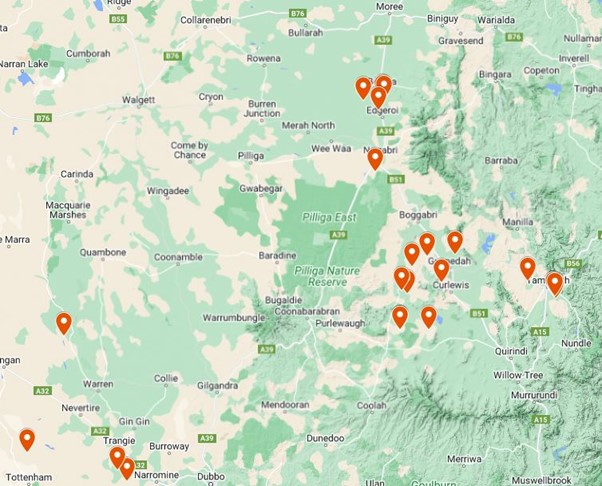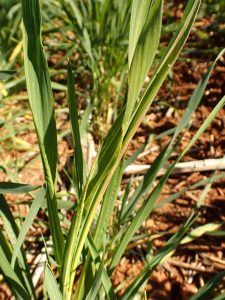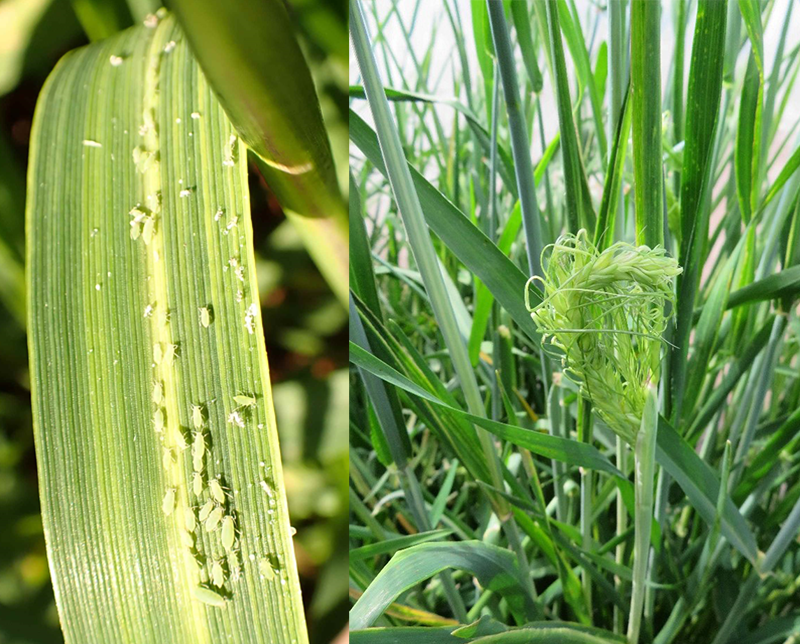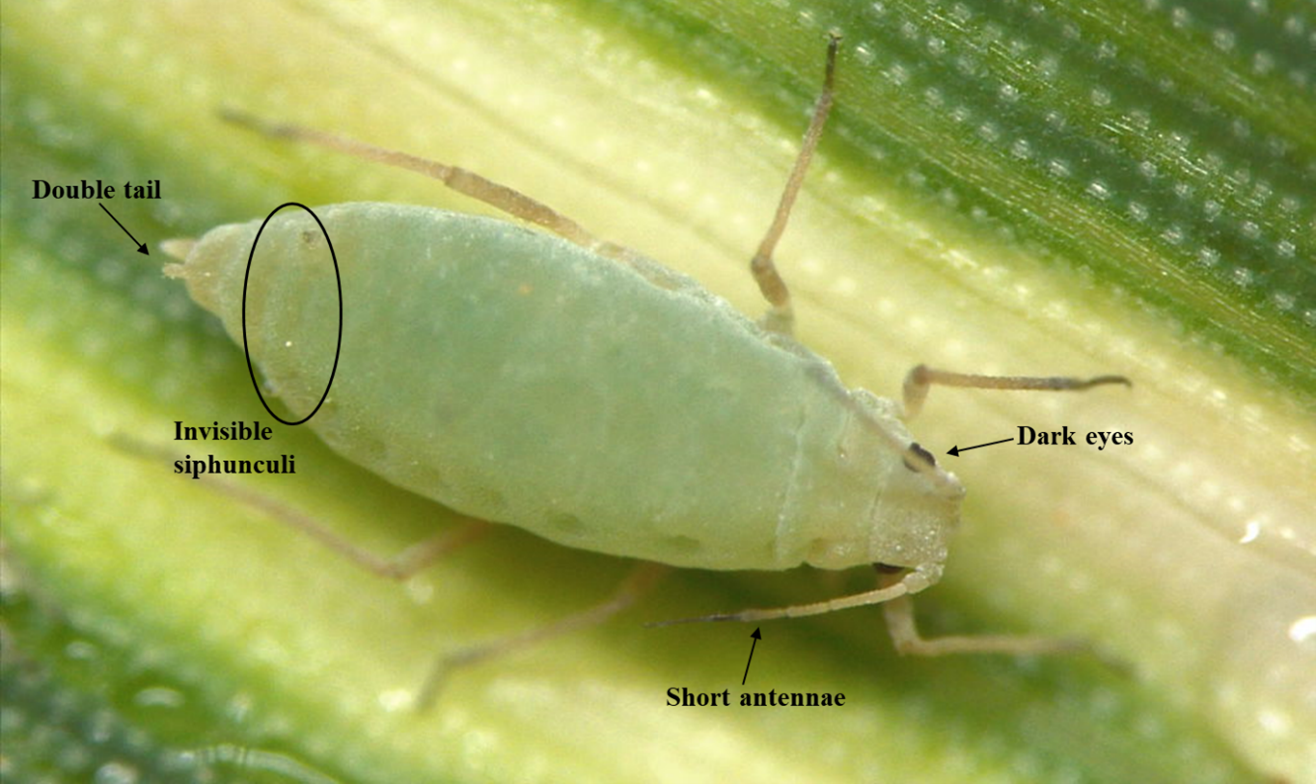Detections of Russian wheat aphid Diuraphis noxia (RWA) in New South Wales appeared later than usual this year. RWA was detected in Tambar Springs in northern New South Wales (NSW) in August 2023, followed by detections in the Liverpool Plains, Trangie and Moree Plains.
More than 60 cereal and grass samples were collected in northern NSW between April and July 2023, however there were no signs of RWA presence.

RWA positive samples collected during August 2023 (prepared by M. Chalise, NSW DPI)
Crops typically experience infestations of RWA in warmer autumn conditions when the aphids move from grasses into early planted cereals. However, this anticipated scenario did not eventuate in northern NSW this year. RWA populations are strongly influenced by environmental factors and it is likely that unfavourable environmental conditions (including a high level of total autumn rainfall) in various locations, including Tamworth, led to a delay in the movement of RWA.
When the crops in Liverpool and Moree Plains were examined, RWA was detected in low numbers (1-2% of tillers infested). Although there were predatory beneficial species such as ladybeetles present, no parasitised aphids were found, suggesting that this infestation was detected early, before beneficials had time to establish control. With the warm spring conditions, increased activity of beneficials is expected.
To date, infestations have been detected in wheat and barley, both with and without insecticide seed treatment, and in barley grass. The growth stage of the crops was approximately GS 30-32 at the time of inspection, except the crops in Moree Plains which were in heading and flowering growth stage.
Identifying Russian wheat aphid
Differentiating RWA from other cereal aphids is straightforward. RWA is characterised by its small size (2 mm long) and pale green, spindle-like shaped body. Additionally, it is commonly coated in delicate wax. RWA has dark eyes, antennae that are less than half its body length, nearly invisible siphunculi (also called exhaust pipes), and a projection above the cauda that creates the appearance of having two tails.
Russian wheat aphid host range
RWA primarily infests barley, wheat and durum wheat, followed by oats, sorghum and triticale. It may also be found in winter and summer wild grasses. During field surveys carried out in 2018 and 2019, RWA was identified on barley, wheat, durum wheat and barley grass in the northern region. While wheat and barley serve as favourable hosts for RWA for a significant part of the year, the presence of wild grasses is crucial for maintaining population levels, especially during the summer months, and they act as a ‘green bridge’ for the infestation of cereals in the autumn.
Damage

Symptoms of RWA presence – white, yellow and purple strips, and rolled leaves along margins
RWA does not effectively transmit plant viruses and its most significant impact on crop yield comes from direct feeding. While feeding and probing, RWA injects toxins from its saliva into the host plant tissue. Consequently, cereal plants can exhibit a range of symptoms, including streaking of leaves with longitudinal white and/or yellow and sometimes purple markings, as well as the curling of leaves along their edges, followed by chlorosis, necrosis, wilting and stunted growth. In instances where probing takes place during the formation of the head, it could lead to the formation of trapped awns or bleached heads, or potential failure of the flowering process.

RWA colony hidden inside rolled leaves (left) and trapped awns as a symptom of RWA presence (right)
Typically, the initial infestations are detected on the edge of the field. Between the early booting and soft dough growth stages, RWA can cause direct yield losses by feeding, however beyond the soft dough stage, the impact is greatly reduced.
Monitoring and thresholds
To effectively manage RWA populations, it is essential to monitor their density by analysing the percentage of tillers between GS30 and GS50 that are affected by RWA. Monitoring at early growth stages allows time to organise control, if necessary.
Thresholds have been developed to guide decisions around RWA control, based on the potential loss an infestation will cause. The threshold calculation requires an estimate of the proportion (%) of tillers infested with RWA.
The recommended monitoring approach is to inspect 50 cm of row and count the number of infested tillers. Quickly check an additional 20 nearby tillers to ensure the sample is representative. Repeat at five randomly selected points across the field, but also check stressed areas (which are often the first to be infested) as well as the field edges and the interior of the field. Calculate the percentage of tillers with RWA and estimate cost of control, cereal market price, yield potential and days until GS50. Enter these into the RWA action threshold calculator (links to external website).
The action threshold calculator indicates the economic injury level during sensitive growth stage and assists in making informed management decisions. RWA can be effectively managed if infestations are detected in time to prevent yield loss.
Also keep an eye on the presence of beneficial insects. The highest infestation usually occurs between GS40 (early booting) up to GS50 (heading and flowering). During this period, beneficial insects are likely to be active and contributing to slowing the RWA population growth.
When applying insecticide, consult the APVMA website to ensure compliance with current permits and registrations. Additionally, consider using softer options like the selective aphicide pirimicarb, which is less toxic to beneficial insects, but will still negatively impact aphid parasitoids. More information on the relative toxicity of insecticide options is available at the GRDC website.
Further information
Additional links to RWA information on the GRDC website:

